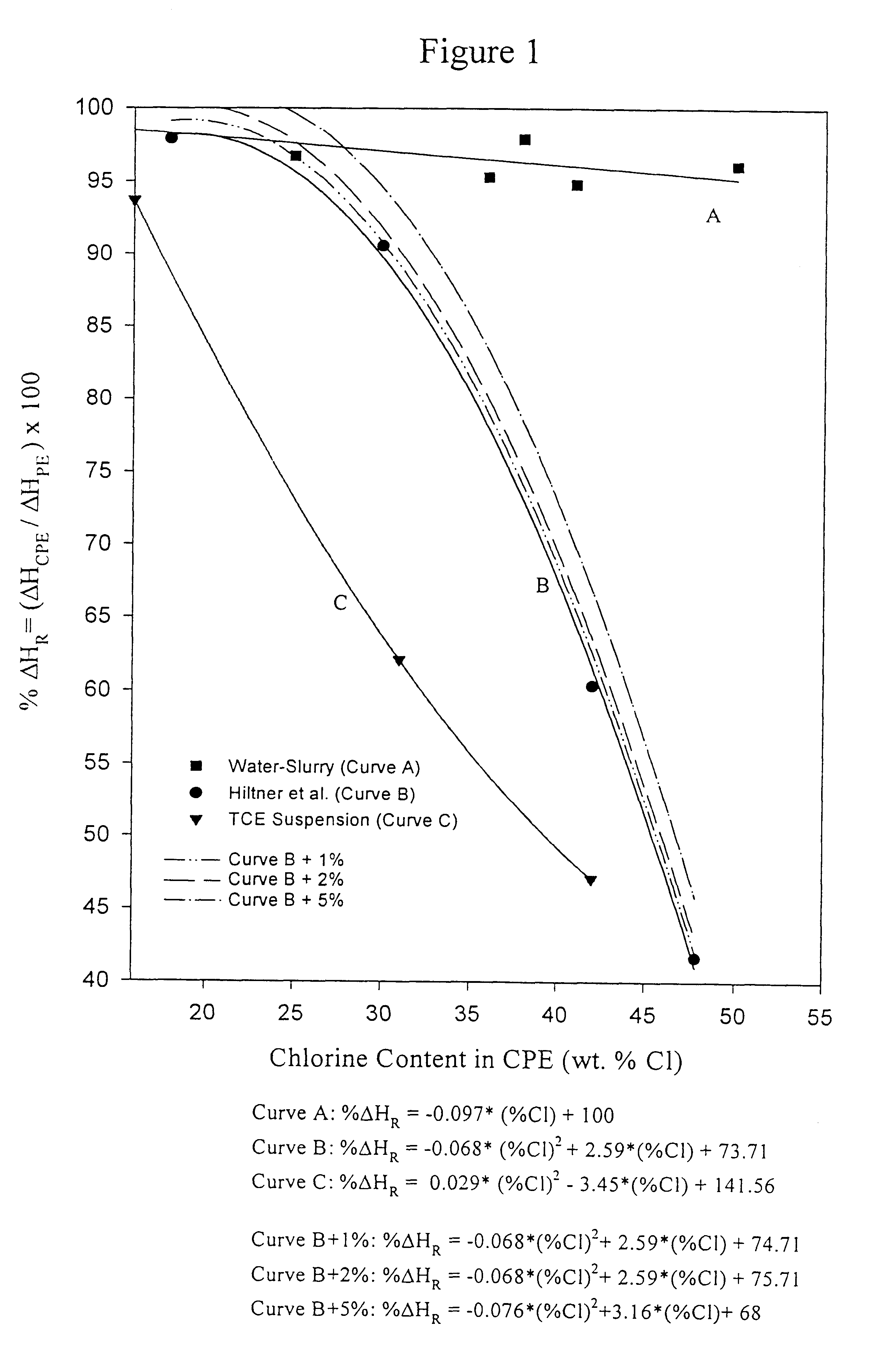Blocky chlorinated polyolefins, process for making and use as impact modifier compatibilizer for PVC or CPVC
a technology of chlorinated polyolefins and impact modifiers, applied in the field of polyolefins, can solve the problems of reducing other desirable properties of pvc or cpvc, using impact modifiers, and high-crystalline polyethylene not being effectively chlorinated
- Summary
- Abstract
- Description
- Claims
- Application Information
AI Technical Summary
Benefits of technology
Problems solved by technology
Method used
Image
Examples
example 1
Chlorinated Polyethylene from UV Irradiation
A 2-gallon jacketed reactor (suitable for chlorination reactions) provided with means of agitation, feed lines, pressure and temperature recording instruments, and appropriate valves and piping was charged with 4000 g of demineralized water, 0.3 g of a commercial wetting agent (Thompson-Hayward T-DET-N8) and 300 g of high density polyethylene powder (Microthene.TM. FA700-00 from Quantum Chemical Corporation), having a density of 0.953 g / cm.sup.3 as measured by ASTM D-1505 on compression molded samples and a melt index of 10.5 g / 10 min according to ASTM D-1238 FR-E. Microthene.TM. powder particles, which are spherical with an average particle size of ca. 20 .mu.m, were slurried in water. After evacuation to 6 psia (pounds per square inch absolute), nitrogen was charged to the reactor until the pressure reached 104 psia. The reactor was again evacuated to 6 psia and nitrogen was added until the pressure was 102 psia. The reactor was again ev...
example 2
Chlorinated Polyethylene from UV Irradiation
Essentially the procedure of Example 1 was used. 300 g of a high density polyethylene pellets (HDPE 9602) purchased from Chevron Chemical, having a density of 0.960 g / cm.sup.3 (ASTM D-4683) and a melt index of 0.25 g / 10 min (ASTM D-1238 FR-E) were cryogenically ground to an average particle size of ca. 250 .mu.m and then charged into the reactor. The total volume of chlorine fed was 250 cm.sup.3. The chlorination was completed in 120 minutes. The chlorine content was measured by .sup.13 C-NMR as described previously and found to be 38 wt. % chlorine. The residual crystallinity was measured by DSC according to the above outlined TA test procedure (ASTM D-3417) and found to be ca. 98% of the starting polyethylene crystallinity.
example 3
Chlorinated Polyethylene from Oxygen Catalyst
Essentially the procedure of Example 2 was used except a trace amount of oxygen was used as the catalyst (by skipping a vacuum purging step) for the chlorination rather than UV irradiation. The reaction temperature was 70.degree. C. and 300 g of a high density polyethylene powder (HDPE 9602) was charged into the reactor. The total volume of chlorine fed was 170 cm.sup.3. The chlorination was completed in 240 minutes. The chlorine content was measured by .sup.13 C-NMR as described previously and found to be 30 wt. %. The residual crystallinity was measured by DSC according to the above outlined TA test procedure (ASTM D-3417) and found to be ca. 93% of the starting polyethylene crystallinity.
PUM
| Property | Measurement | Unit |
|---|---|---|
| chlorination time | aaaaa | aaaaa |
| melting temperature | aaaaa | aaaaa |
| densities | aaaaa | aaaaa |
Abstract
Description
Claims
Application Information
 Login to View More
Login to View More - R&D
- Intellectual Property
- Life Sciences
- Materials
- Tech Scout
- Unparalleled Data Quality
- Higher Quality Content
- 60% Fewer Hallucinations
Browse by: Latest US Patents, China's latest patents, Technical Efficacy Thesaurus, Application Domain, Technology Topic, Popular Technical Reports.
© 2025 PatSnap. All rights reserved.Legal|Privacy policy|Modern Slavery Act Transparency Statement|Sitemap|About US| Contact US: help@patsnap.com



